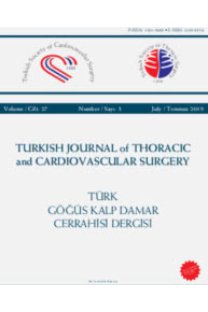Efficacy of preoperative white blood cell count and lymphocyte/monocyte ratio in predicting post-lobectomy pneumonia
___
- 1. Ziarnik E, Grogan EL. Postlobectomy Early Complications. Thorac Surg Clin 2015;25:355-64.
- 2. Imperatori A, Nardecchia E, Dominioni L, Sambucci D, Spampatti S, Feliciotti G, et al. Surgical site infections after lung resection: a prospective study of risk factors in 1,091 consecutive patients. J Thorac Dis 2017;9:3222-31.
- 3. Uramoto H, Nakanishi R, Fujino Y, Imoto H, Takenoyama M, Yoshimatsu T, et al. Prediction of pulmonary complications after a lobectomy in patients with non-small cell lung cancer. Thorax 2001;56:59-61.
- 4. Agostini PJ, Lugg ST, Adams K, Smith T, Kalkat MS, Rajesh PB, et al. Risk factors and short-term outcomes of postoperative pulmonary complications after VATS lobectomy. J Cardiothorac Surg 2018;13:28.
- 5. Schussler O, Alifano M, Dermine H, Strano S, Casetta A, Sepulveda S, et al. Postoperative pneumonia after major lung resection. Am J Respir Crit Care Med 2006;173:1161-9. 6. Berry MF, Hanna J, Tong BC, Burfeind WR Jr, Harpole DH, D'Amico TA, et al. Risk factors for morbidity after lobectomy for lung cancer in elderly patients. Ann Thorac Surg 2009;88:1093-9.
- 7. Wang S, Li X, Li Y, Li J, Jiang G, Liu J, et al. The longterm impact of postoperative pulmonary complications after video-assisted thoracic surgery lobectomy for lung cancer. J Thorac Dis 2017;9:5143-52.
- 8. Bommart S, Berthet JP, Durand G, Pujol JL, Mathieu C, Marty-Ané C, et al. Imaging of postoperative complications following surgery for lung cancer. Diagn Interv Imaging 2017;98:11-20.
- 9. Yang J, Xia Y, Yang Y, Ni ZZ, He WX, Wang HF, et al. Risk factors for major adverse events of video-assisted thoracic surgery lobectomy for lung cancer. Int J Med Sci 2014;11:863-9.
- 10. Alpert JB, Godoy MC, Degroot PM, Truong MT, Ko JP. Imaging the post-thoracotomy patient: anatomic changes and postoperative complications. Radiol Clin North Am 2014;52:85-103.
- 11. Kim HJ, Cha SI, Kim CH, Lee J, Cho JY, Lee Y, et al. Risk factors of postoperative acute lung injury following lobectomy for nonsmall cell lung cancer. Medicine (Baltimore) 2019;98:e15078.
- 12. Irie M, Nakanishi R, Yasuda M, F ujino Y, Hamada K, Hyodo M. Risk factors for short-term outcomes after thoracoscopic lobectomy for lung cancer. Eur Respir J 2016;48:495-503.
- 13. Batchelor TJP, Rasburn NJ, Abdelnour-Berchtold E, Brunelli A, Cerfolio RJ, Gonzalez M et al. Guidelines for enhanced recovery after lung surgery: recommendations of the Enhanced Recovery After Surgery (ERASVR ) Society and the European Society of Thoracic Surgeons (ESTS). Eur J Cardiothorac Surg 2018;1-25.
- 14. Fernandes EO, Teixeira C, Silva LC. Thoracic surgery: risk factors for postoperative complications of lung resection. Rev Assoc Med Bras (1992) 2011;57:292-8.
- 15. Stotz M, Pichler M, Absenger G, Szkandera J, Arminger F, Schaberl-Moser R, et al. The preoperative lymphocyte to monocyte ratio predicts clinical outcome in patients with stage III colon cancer. Br J Cancer 2014;110:435-40.
- 16. Yang YT, Jiang JH, Yang HJ, Wu ZJ, Xiao ZM, Xiang BD. The lymphocyte-to-monocyte ratio is a superior predictor of overall survival compared to established biomarkers in HCC patients undergoing liver resection. Sci Rep 2018;8:2535.
- 17. Kawaguchi Y, Hanaoka J, Ohshio Y, Igarashi T, Kataoka Y, Okamoto K, et al. A risk score to predict postoperative complications after lobectomy in elderly lung cancer patients. Gen Thorac Cardiovasc Surg 2018;66:537-42.
- 18. Saito H, Hatakeyama K, Konno H, Matsunaga T, Shimada Y, Minamiya Y. Impact of pulmonary rehabilitation on postoperative complications in patients with lung cancer and chronic obstructive pulmonary disease. Thorac Cancer 2017;8:451-60.
- 19. Jing R, He S, Dai H, Lin F, Ge W, Tao G, et al. Incidence and risk factors of postoperative pulmonary complications after thoracic surgery for early non-small cell lung cancer. Int J Clin Exp Med 2018;11:285-94.
- 20. Çırak Y, Karahan Z, Yelvar Deniz Yılmaz G, Erden İ, Demirkılıç U. Is physiotherapy effective on the occurrence of postoperative pulmonary complications in patients undergoing coronary artery bypass graft surgery? A randomised controlled trial. Turk Gogus Kalp Dama 2015;23:622-30.
- ISSN: 1301-5680
- Yayın Aralığı: Yılda 4 Sayı
- Başlangıç: 1991
- Yayıncı: Bayçınar Tıbbi Yayıncılık
Langerhans cell histiocytosis: A rare cause of pathological rib fracture
Alkım YOLCU, Cumhur Murat TULAY, Peyker TEMİZ, İsmet AYDOĞDU
Bülent Mustafa YENİGÜN, Yusuf KAHYA, Çiğdem SOYDAL, Nihal Ata TUTKUN, Gökhan KOCAMAN, Muhammed Emre KOÇAK, Elgin ÖZKAN, Serpil DİZBAY SAK, Ayten KAYI CANGIR
Endobronchial treatment of benign endobronchial neoplasms: Our 10 years of experience
Demet TURAN, Mehmet Akif ÖZGÜL, Ekrem Cengiz SEYHAN, Efsun UĞUR, Güler ÖZGÜL, Erdoğan ÇETİNKAYA
Reconstruction of large chest wall defects using three-dimensional custom-made implant technology
Hakan IŞIK, Merve Şengül İNAN, Kuthan KAVAKLI, Sedat GÜRKÖK
Hüseyin Ayhan, Bilge Duran Karaduman, Telat Keleş, Engin Bozkurt
A rare cardiac tumor presenting with myxoma: Primary cardiac hemangioendothelioma
Ertürk KARAAĞAÇ, Nihan YEŞİLKAYA, Tahsin Murat TELLİOĞLU, Fulya ÇAKALAĞAOĞLU ÜNAY, Yüksel BEŞİR
Ahmet Barış Durukan, Hakan Göçer, Osman Tunç, Erdinç Naser, Ercan Ertuğrul, Hasan Alper Gürbüz
Four ectopia cordis cases surgically managed with different strategies
Kaan YILDIZ, Mustafa KIR, Baran UĞURLU, Halise Zeynep GENÇ, Nurettin ÜNAL
